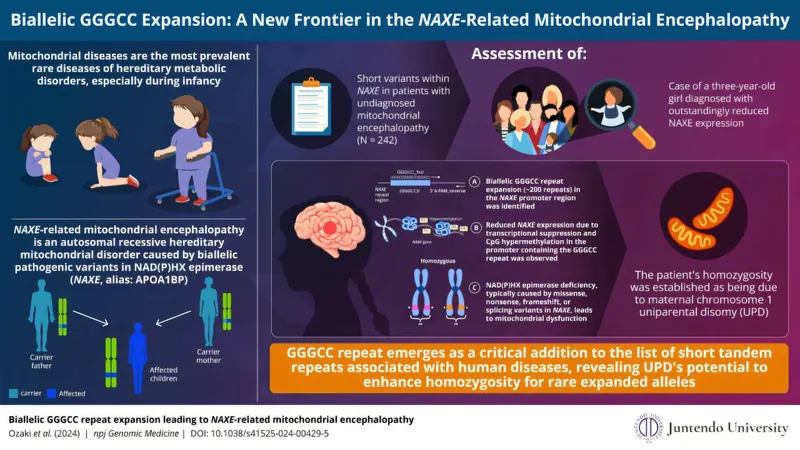
Groundbreaking Discovery: New Genetic Repeat Expansion Linked to Mitochondrial Encephalopathy in Young Patient!
2024-11-18
Author: Wei
New Genetic Insights into Mitochondrial Diseases
Researchers have long grappled with the complexities of mitochondrial diseases, a group of hereditary metabolic disorders that affect approximately 1 in every 5,000 births worldwide. While many of these conditions are attributed to single nucleotide variations or structural changes, new insights suggest that repeat expansions within nuclear genes can also significantly impair mitochondrial function, leading to severe repercussions, particularly in the central nervous system (CNS).
A Revolutionary Study
In a recent study published in npj Genomic Medicine on October 25, 2024, an innovative research team led by Professor Yasushi Okazaki and Dr. Kei Murayama from Juntendo University, Japan, shed light on a previously unidentified mechanism causing mitochondrial encephalopathy. Their investigation focused on a 3-year-old girl diagnosed with NAXE-related mitochondrial encephalopathy, a rare disorder linked to faulty variants in the NAD(P)HX epimerase enzyme.
A Unique Case
The story behind this case began when the team set out to analyze molecular diagnostics for 2,932 undiagnosed patients with mitochondrial disorders. Their rigorous approach included RNA sequencing from fibroblast samples and genomic sequencing from 400 patients. They discovered that 303 of these individuals were biochemically confirmed to have mitochondrial diseases, leading them to conduct an in-depth bioinformatics analysis that revealed significant gene dysregulation.
Symptoms and Genetic Findings
Among their findings was the case of the young girl, who presented with symptoms like truncal instability, seizures, mild developmental delays, and hearing difficulties. Remarkably, the team identified a staggering GGGCC repeat expansion—nearly 200 repetitions—within the NAXE promoter region, in stark contrast to the typical three repeats found in healthy individuals. This expansion contributed to a dramatic reduction in NAXE gene expression, which they attributed to hypermethylation caused by the extensive repeats.
Maternal Uniparental Disomy
Further genetic insights revealed that the girl’s condition stemmed from maternal uniparental disomy (UPD) on chromosome 1, a rare genetic anomaly where a child inherits two copies of a chromosome from one parent. This finding highlighted a crucial piece of the puzzle in understanding repetitive sequences and their role in gene regulation.
Significance of the Findings
Professor Okazaki emphasized the significance of this research, stating, “While our technology has enabled us to identify a novel repeat expansion in a single patient, it opens up new avenues for uncovering similar cases in larger cohorts such as those with undiagnosed mitochondrial diseases.”
Potential Implications
The implications of these findings are profound, especially since pathogenic repeat expansions can wreak havoc through translated peptide accumulation or through defective protein synthesis. Unlike many cases, however, the severe decrease in NAXE mRNA levels in this patient could mitigate some cytotoxic effects, suggesting a unique aspect of this repeat expansion that requires further investigation.
Future Directions and Hope
This study serves as a testament to the potential of advanced sequencing technologies to unveil genetic factors that have remained elusive. Although the discovery is still in its infancy, it paves the way for future research that may not only illuminate other potential NAXE variants but also help to comprehend the impact of GGGCC expansions on a larger scale. Mitochondrial diseases and their varied manifestations continue to pose significant diagnostic challenges. However, breakthroughs like this research signify hope for patients and families battling these complex conditions. As scientists extend their scope to explore the impact of UPD and repetitive sequences, the path towards accurate diagnoses and effective treatments could become clearer than ever. Stay tuned for more updates in this thrilling field!


 Brasil (PT)
Brasil (PT)
 Canada (EN)
Canada (EN)
 Chile (ES)
Chile (ES)
 España (ES)
España (ES)
 France (FR)
France (FR)
 Hong Kong (EN)
Hong Kong (EN)
 Italia (IT)
Italia (IT)
 日本 (JA)
日本 (JA)
 Magyarország (HU)
Magyarország (HU)
 Norge (NO)
Norge (NO)
 Polska (PL)
Polska (PL)
 Schweiz (DE)
Schweiz (DE)
 Singapore (EN)
Singapore (EN)
 Sverige (SV)
Sverige (SV)
 Suomi (FI)
Suomi (FI)
 Türkiye (TR)
Türkiye (TR)